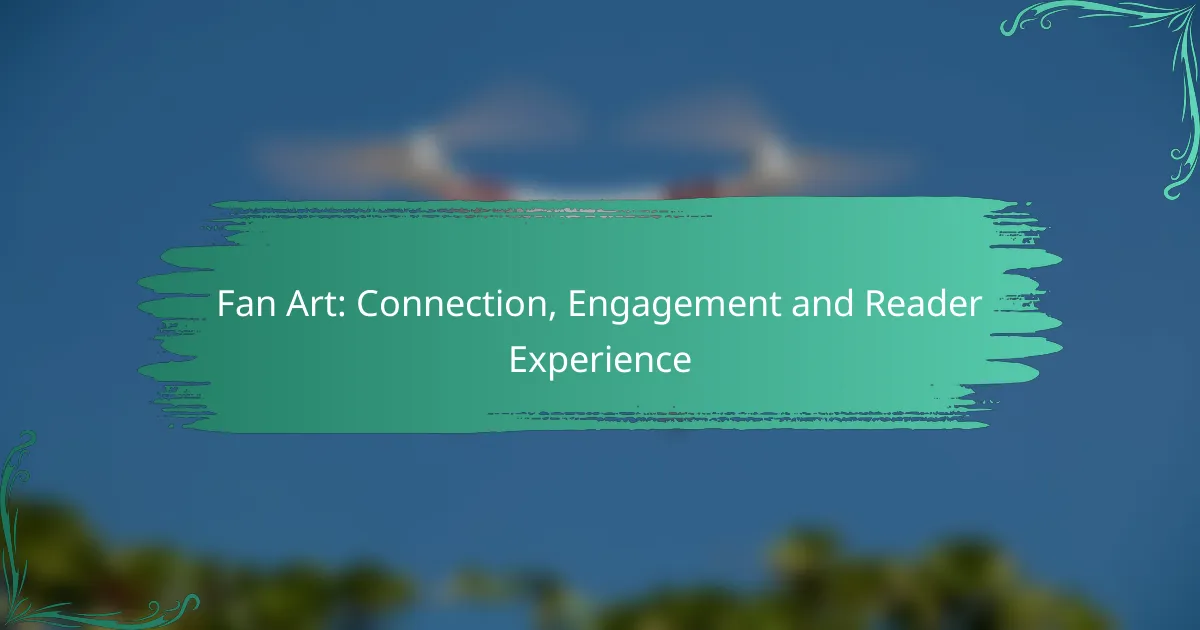Fan art serves as a powerful medium for readers to deepen their connection with beloved characters and stories, transforming passive consumption into active engagement. By expressing their creativity, fans not only showcase their passion but also cultivate a vibrant community that enhances the overall reader experience.
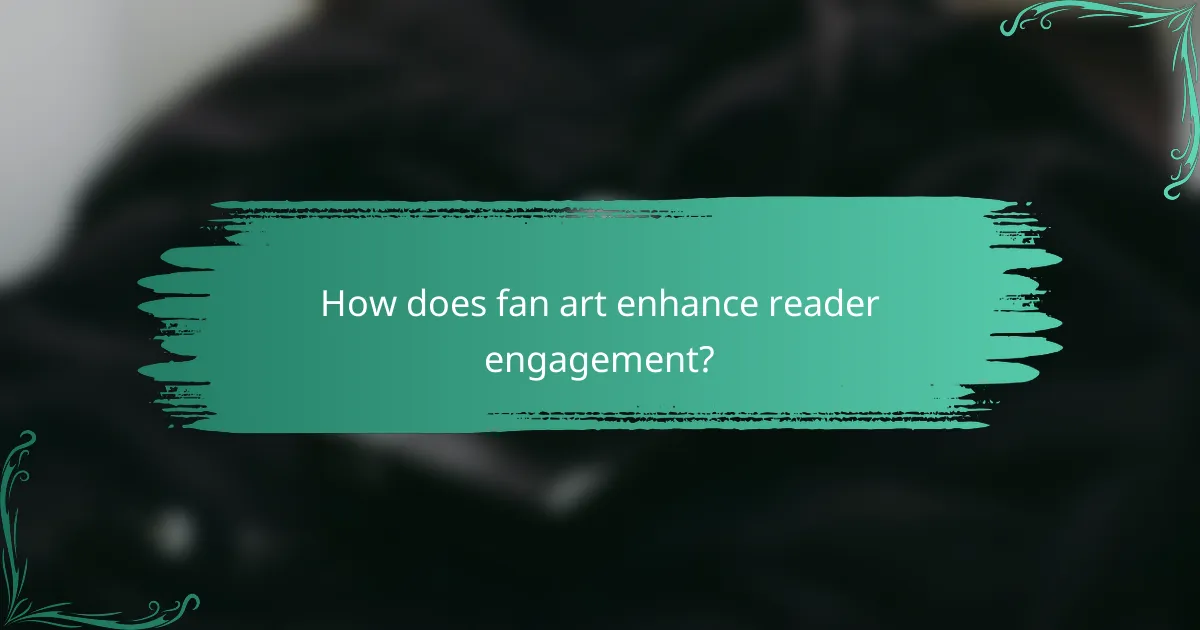
How does fan art enhance reader engagement?
Fan art enhances reader engagement by allowing fans to express their passion for characters and stories, creating a deeper connection with the source material. This form of creative expression fosters a sense of belonging and community among fans, enriching their overall experience.
Emotional connection to characters
Fan art enables readers to explore their emotional ties to characters in a visual and personal way. By interpreting characters through their own artistic lens, fans can convey feelings and narratives that resonate with their experiences. This connection often leads to a more profound appreciation of the original work.
For instance, a fan might create artwork that highlights a character’s struggles or triumphs, allowing others to see familiar themes from a new perspective. This shared emotional journey can deepen the bond between fans and the narrative.
Community building among fans
Creating and sharing fan art fosters a sense of community among fans, as it provides a platform for interaction and collaboration. Online forums, social media, and fan conventions often showcase these artworks, allowing fans to connect over shared interests and passions.
Participating in fan art challenges or collaborations can enhance this sense of belonging. Fans can support each other by providing feedback, sharing techniques, or simply appreciating each other’s work, which strengthens the community ties.
Interactive experiences through fan creations
Fan art creates interactive experiences by inviting fans to engage with the source material in innovative ways. This can include creating fan comics, animations, or even games that expand on the original story, allowing for new interpretations and narratives.
For example, a fan might develop a short animated clip that reimagines a pivotal scene, encouraging discussions and debates among viewers. These interactive elements not only enhance engagement but also inspire others to contribute their own creations, further enriching the fan experience.
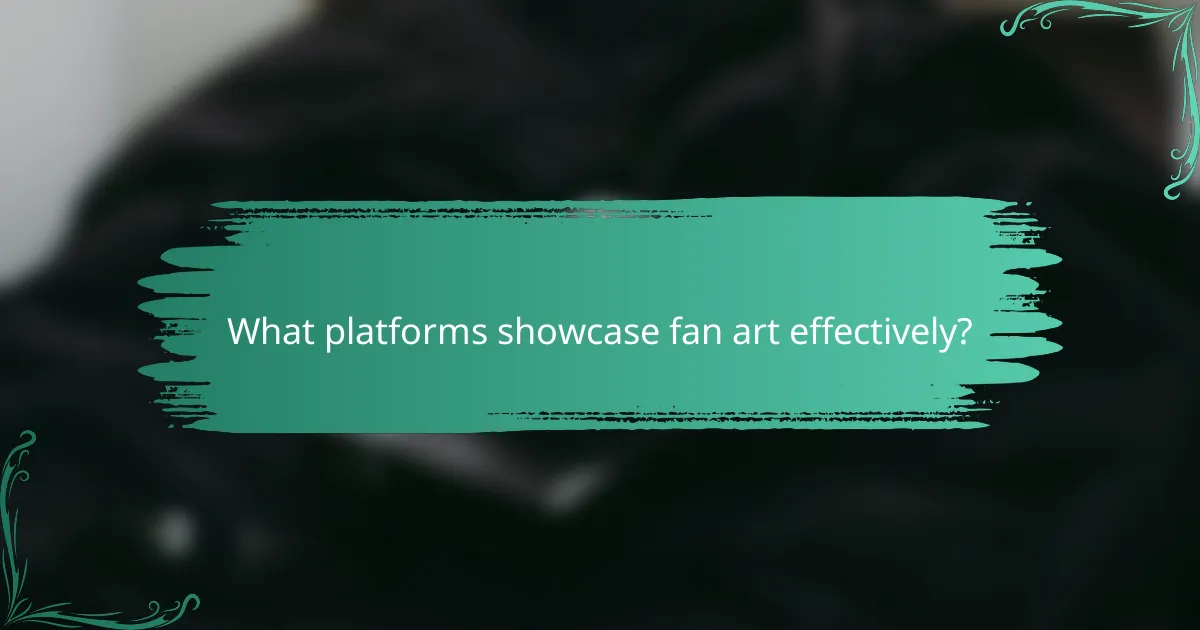
What platforms showcase fan art effectively?
Several platforms effectively showcase fan art, allowing artists to connect with audiences and engage in creative communities. Popular choices include DeviantArt, Instagram, and Redbubble, each offering unique features that cater to different artistic styles and monetization options.
DeviantArt for diverse styles
DeviantArt is a long-standing platform that supports a wide range of artistic styles, from traditional to digital art. Artists can create profiles, upload their work, and receive feedback from a large community of fellow creators and fans.
When using DeviantArt, consider participating in groups and contests to increase visibility. Engaging with other artists through comments and favorites can also help build a supportive network and enhance your exposure.
Instagram for visual storytelling
Instagram excels in visual storytelling, making it an ideal platform for fan artists to showcase their work through captivating images and engaging captions. The platform’s emphasis on aesthetics allows artists to curate their profiles and connect with followers through consistent themes and styles.
To maximize engagement on Instagram, use relevant hashtags and participate in trends like art challenges. Posting stories and reels can also provide a behind-the-scenes look at your creative process, fostering a deeper connection with your audience.
Redbubble for monetization opportunities
Redbubble offers fan artists a chance to monetize their work by selling prints and merchandise featuring their designs. This platform allows artists to upload their artwork, which can then be printed on various products, such as t-shirts, stickers, and home decor.
When using Redbubble, be mindful of copyright regulations and ensure that your designs comply with their guidelines. Promoting your products on social media can help drive traffic to your Redbubble store and increase sales potential.
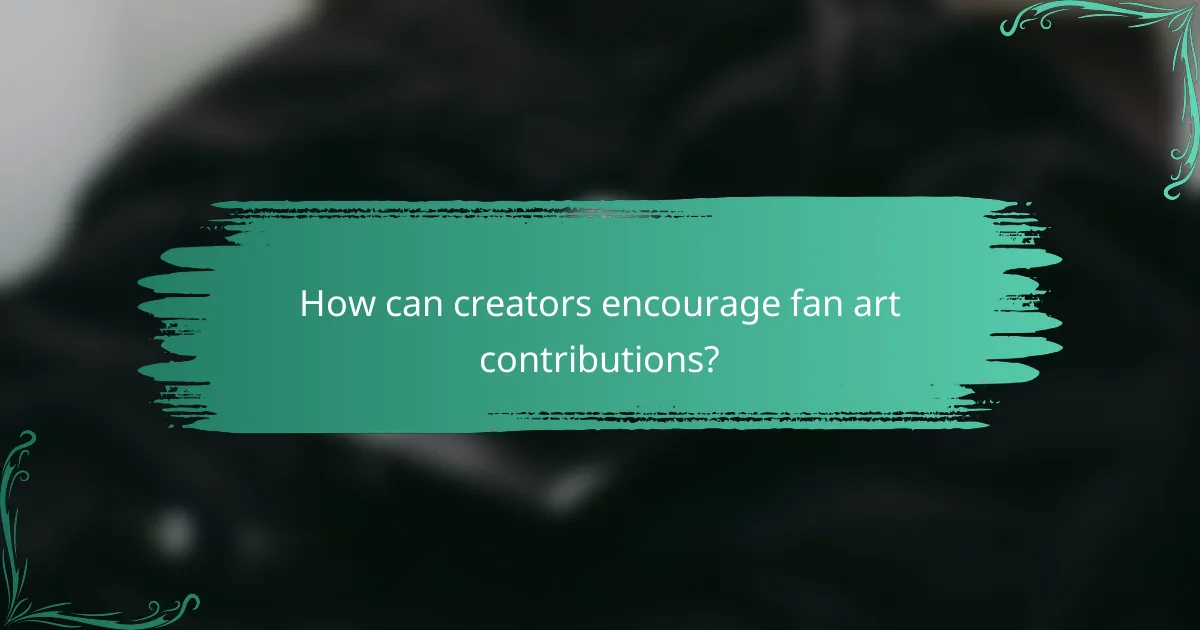
How can creators encourage fan art contributions?
Creators can encourage fan art contributions by actively engaging with their audience and providing structured opportunities for artists to showcase their work. This can be achieved through contests, clear guidelines, and social media interactions that foster a sense of community.
Hosting contests and challenges
Hosting contests and challenges is an effective way to motivate artists to create fan art. These events can offer prizes, such as merchandise or recognition, which can attract a wide range of participants. For example, a monthly theme-based challenge can keep the community engaged and encourage regular submissions.
When organizing contests, consider setting clear rules and deadlines to ensure fairness and clarity. Promote the event across various platforms to maximize participation and visibility.
Providing clear guidelines and themes
Clear guidelines and themes help artists understand what is expected of them, making it easier for them to contribute. Providing specific prompts or themes can spark creativity and give direction to their work. For instance, a theme like “favorite character in a new setting” can inspire unique interpretations.
Additionally, offering examples of previous fan art can serve as inspiration and set a standard for quality. Ensure that guidelines are accessible and straightforward to avoid confusion.
Engaging with artists on social media
Engaging with artists on social media platforms is crucial for building a supportive community. Creators should actively comment on and share fan art, acknowledging the efforts of artists. This not only encourages more contributions but also fosters a sense of belonging among fans.
Utilizing hashtags related to the fan art community can increase visibility and encourage artists to share their work. Regularly featuring fan art on official channels can motivate artists to participate and feel valued.
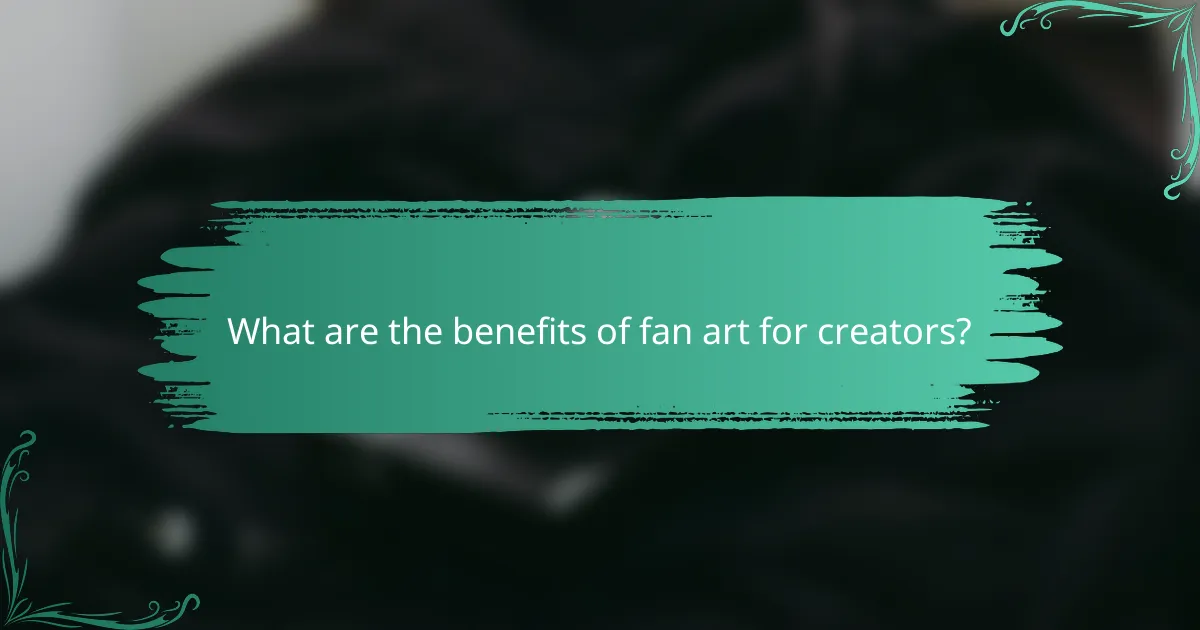
What are the benefits of fan art for creators?
Fan art offers creators a unique opportunity to enhance their visibility and engage with their audience. By encouraging artistic expression from fans, creators can foster a deeper connection and gather valuable insights into their work.
Increased visibility and reach
Fan art can significantly boost a creator’s visibility by reaching new audiences. When fans share their artwork on social media platforms, it often attracts attention from users who may not be familiar with the original work, thereby expanding the creator’s reach.
Creators can leverage this visibility by engaging with fan art through shares or comments, which can further amplify their presence online. Utilizing hashtags related to the artwork can also help in reaching a broader audience.
Feedback on character design and story
Fan art serves as a valuable source of feedback regarding character design and story elements. Fans often interpret characters in unique ways, providing creators with insights into how their work resonates with the audience.
This feedback can guide creators in refining their designs or narratives. For instance, if multiple fan artists depict a character with specific traits, it may indicate a strong connection or interest in those aspects, prompting creators to explore them further.
Strengthened fan loyalty and support
Encouraging fan art can strengthen loyalty among fans, as it fosters a sense of community and belonging. When creators acknowledge and celebrate fan contributions, it reinforces fans’ emotional investment in the work.
Creators can cultivate this loyalty by hosting fan art contests or featuring fan art in their official channels. This not only recognizes the fans’ efforts but also motivates them to continue supporting the creator’s projects in the future.
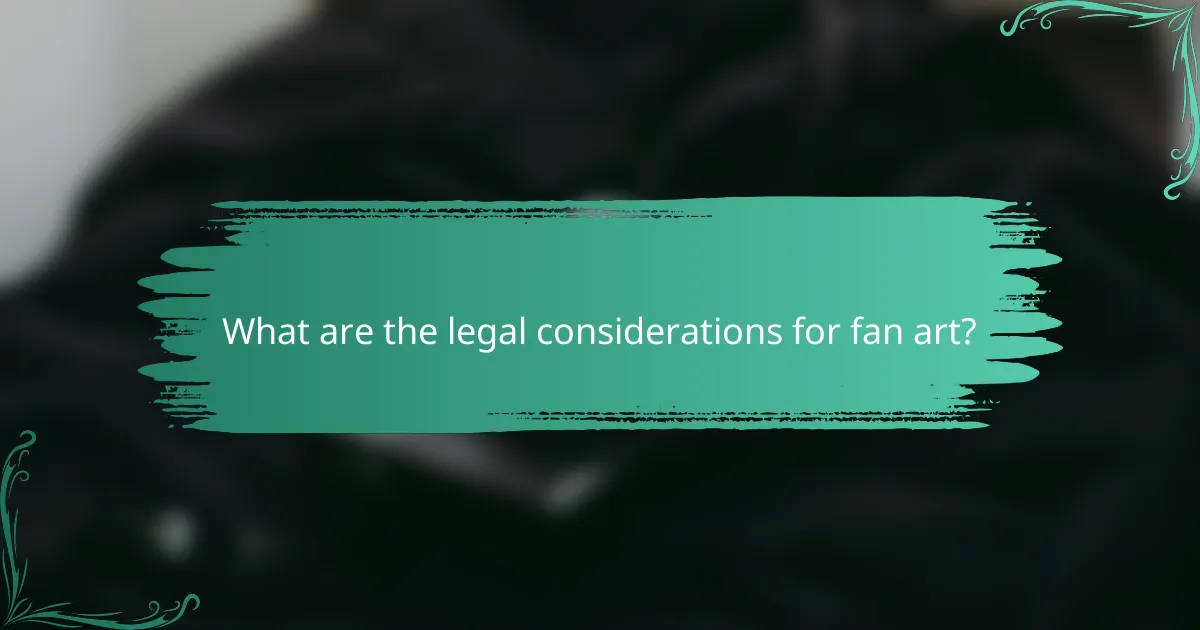
What are the legal considerations for fan art?
Legal considerations for fan art primarily revolve around copyright laws and fair use principles. Artists must navigate the complexities of intellectual property rights to avoid potential legal issues while creating and sharing their work.
Copyright issues and fair use
Copyright laws protect original works, including characters and settings from films, books, and games. Fan art often falls into a gray area where it may be considered transformative, which can qualify it for fair use, but this is not guaranteed.
To determine fair use, consider factors such as the purpose of the artwork, the nature of the original work, the amount used, and the effect on the market for the original. Many fan artists find that non-commercial works are less likely to face legal challenges.
Attribution and crediting artists
Attributing and crediting the original creators of the characters or works you are depicting in fan art is essential. Proper attribution not only shows respect for the original creators but can also help mitigate legal risks.
When sharing fan art online, include clear credits for the original source, and consider linking to the original work or creator’s profile. This practice fosters community goodwill and can enhance your reputation as an artist.
Licensing agreements with creators
Some creators offer licensing agreements that allow fan artists to use their characters or settings legally. These agreements can provide clarity on what is permissible and may include specific terms regarding distribution and sales.
Before proceeding with fan art that you intend to sell or distribute widely, reach out to the original creator for permission. This proactive approach can prevent misunderstandings and potential legal disputes down the line.
